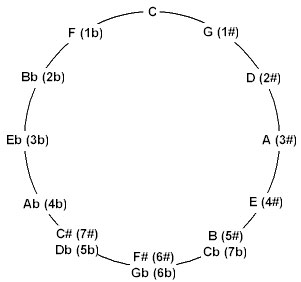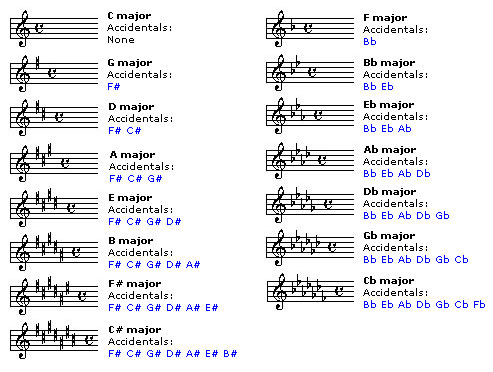Part One: Melody
Focuses on single note soloing. Learn how to effortlessly solo through complex chord changes.
Free Jazz Guitar Lessons with Chris Standring
There are 12 keys. The following chart represents all
the keys and I have endeavored to explain what is commonly known as the
"circle of fifths". Let's look at the top of the circle first
of all. You will see "C". C major has no sharps or flats in
its key signature. Look to the right in the diagram and you will see "G".
G has one sharp in its key signature and is a perfect 5th away from "C",
the previous key. (G is the 5th note in the C major scale). Look to the
right again and you will see "D". D major has two sharps and
again, is a perfect 5th away from the previous key of G. (D is the 5th
note in the G major scale). Continue around the circle again and you will
come to A major, which has three sharps and is a perfect 5th away from
the previous key of D and so on.
Keep continuing around the circle until it starts over at C major again,
back at the top of the circle. You will notice that there are three keys
in the circle that have two different names. B is the same as Cb. F# is
the same as Gb and C# is the same as Db. These are known as enharmonic
keys (they sound the same, but are notated differently). In a practical
situation you would use B instead of Cb as it is easier to think of 5
sharps rather than 7 flats. Also you would use Db instead of C#, because
it is better to think of 5 flats instead of 7 sharps. Since F# and Gb
have an equal number of sharps and flats, either can be used. C# and Cb
are considered more "theoretical" keys than actual usable keys,
so you will rarely see them.

Here are all the key signatures with their respective accidentals:

It is a good idea to memorize these keys and to know exactly what accidentals
each contains. There is a really easy little rhyme to help you remember
this. First, remember that C major has no sharps or flats. Easy. Then:
For sharp
keys:
Father Charles
Goes Down
And Ends
Battle
For flat
keys:
Battle Ends
And Down
Goes Charles
Father
It might take a while to really know these keys inside out so don't drive
yourself nuts if this doesn't sink in for a while. Know the theory behind
the keys as I have explained above and the more you actually play in a
key, the more each will really hit home with you and become comfortable.
Relative Minor Keys
For every major key there is a relative minor key. Our relative
minor key chord is chord 6 in our major chord scale sequence. Just to
remind you:

So the relative minor of C major is therefore A minor.
Makes sense? All the key chords pertaining to the key of A minor are (for
our present purposes) the same as C major except that in order for us
to really establish our new key center of A minor, it is necessary for
us to include the chord of E7 because if we were to play a perfect cadence
in A minor, we would need to go v - i (chord 5 going to chord 1), just
like we would in a major key. Our v chord is always dominant remember?
or dominant 7th. (in the key of C major, our v dominant chord is G7).
So in the key of A minor, our v dominant chord would be E7 (not E minor
as the key of C major would suggest).
In any major key, simply count up six steps to find out what the relative
minor key is:
| Major | Relative Minor |
| C major | A minor |
| G major | E minor |
| D major | B minor |
| A major | F# minor |
| E major | C# minor |
| B major | G# minor |
| F# major | D# minor |
| C# major | A# minor |
| F major | D minor |
| Bb major | G minor |
| Eb major | C minor |
| Ab major | F minor |
| Db major | Bb minor |
| Gb major | Eb minor |
| Cb major | Ab minor |
Free online jazz guitar lessons for beginners, intermediates and advanced.
Online jazz guitar instruction from recording artist Chris Standring
Join The Inside Track membership and get access to all Chris Standring's guitar instructional programs, all in one place.
It has been many years since the first edition of Play What You Hear (originally released in 2000). Now volume two is here with new ideas and concepts, complete with audio, video, traditional notation and TAB throughout. High resolution pdf available for printing the entire program. For intermediate and advanced players.
Focuses on single note soloing. Learn how to effortlessly solo through complex chord changes.
Focuses on chord melody. Learn new harmonic devices and understand chords in a whole new way.
Study Chris Standring's six recorded solos, transcribed with audio and high def video.
Copyright © PlayJazzGuitar.com - All Rights Reserved.